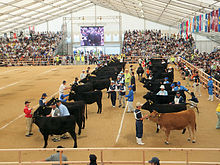Wagyu beef - Simple English Wikipedia, the free encyclopedia
The English used in this article or section may not be easy for everybody to understand. (January 2024) |

Wagyu beef is the beef that comes from the Japanese Wagyu cattle.[1] It is very expensive and regarded as one of the best slices of beef.[2] There is a lot of marbling in the meat, which means that there are streaks of fat within the red meat which makes the meat tenderer and moister, while adding flavor. Sometimes the Wagyu beef is called different things based on where it is from. Some examples include Kobe beef, Matsusaka beef, or Omi beef.
There are 9 prefectures that raise Wagyu cattle, Miyazaki Prefecture, Hokkaido, Kagoshima Prefecture, Shiga Prefecture, Miyagi Prefecture, Gifu Prefecture, Kumamoto Prefecture, Hyogo Prefecture, and Kagawa Prefecture.[3]
History
[change | change source]
Cattle were brought to Japan from China at the same time as the cultivation of rice, in about the second century AD, in the Yayoi period.[4]: 209 Until about the time of the Meiji Restoration in 1868, they were used only as draught animals, in agriculture, forestry, mining and for transport, and as a source of fertilizer. Milk consumption was unknown, and – for cultural and religious reasons – meat was not eaten. Cattle were highly prized and valuable, too expensive for a poor farmer to buy.[5]: 2
Japan was effectively isolated from the rest of the world from 1635 until 1854; there was no possibility of the intromission of foreign genes to the cattle population during this time. Between 1868, the year of the Meiji Restoration, and 1887, some 2600 foreign cattle were imported.[5]: 7 At first, there was little interest in cross-breeding these with the native stock, but from about 1900, it became widespread. It was ceased abruptly in 1910 when it was realized that, while the cross-breeds might be larger and have better dairy qualities, their working capacity and meat quality was lower.[5]: 7 From 1919, the various heterogeneous regional populations that resulted from this brief period of cross-breeding were registered and selected as "Improved Japanese Cattle". Four separate strains were characterised, based mainly on which type of foreign cattle had most influenced the hybrids, and were recognised as individual breeds in 1944.[5]: 8 They are collectively known as wagyū, and are:[4]: 66 [6]: 420 [7]
- The Japanese Black (黒毛和種, kuroge washu), which constitutes over 90% of beef cattle in Japan;[8] regional strains within the breed include the Tottori, Tajima, Shimane and Okayama.[9]
- The Japanese Brown or Japanese Red (褐毛和種, akage washu or akaushi), the other main breed, representing about 5% of all beef cattle;[10]: 17 reared in southern Japan, in Kōchi Prefecture on Shikoku island, and in Kumamoto Prefecture on Kyushu island.[5]: 8 [9]
- The Japanese Polled (無角和種, mukaku washu), found principally in Yamaguchi Prefecture[5]: 8
- The Japanese Shorthorn (日本短角和種, nihon tankaku washu), reared in northern Japan, mainly in Iwate Prefecture; it constitutes less than one percent of all wagyu cattle.[11]
In 1997, though, Japan declared the Wagyu breed a living national treasure and placed a ban on exports.[12]
References
[change | change source]- ↑ "What is Wagyu? | American Wagyu Association". wagyu.org. Retrieved 2021-05-26.
- ↑ Kim, Jack Houston, Irene Anna. "The rarest steak in the world can cost over $300. Here's why wagyu beef is so expensive". Business Insider. Retrieved 2021-05-26.
{{cite web}}: CS1 maint: multiple names: authors list (link) - ↑ "HOLY GRAIL'S COMPREHENSIVE GUIDE TO JAPANESE WAGYU". holygrailsteak.com. Holygrail steak. 19 July 2022.
- ↑ 4.0 4.1 Valerie Porter, Lawrence Alderson, Stephen J. G. Hall, D. Phillip Sponenberg (2016). Mason's World Encyclopedia of Livestock Breeds and Breeding (sixth edition). Wallingford: CABI. ISBN 9781780647944.
- ↑ 5.0 5.1 5.2 5.3 5.4 5.5 Kiyoshi Namikawa (2016 [1992]). Breeding history of Japanese beef cattle and preservation of genetic resources as economic farm animals. Kyoto: Wagyu Registry Association. Accessed January 2017.
- ↑ T. Muramoto, M. Higashiyama, T. Kondo (2005). Effect of pasture finishing on beef quality of Japanese Black steers. Asian-Australian Journal of Animal Science 18: 420–426.
- ↑ What Is Wagyu? Japan Meat Information Service Center. Archived 22 October 2013.
- ↑ Ministry of Agriculture, Forestry and Fisheries (August 2019). "肉用牛の改良増殖をめぐる情勢" [The Situation Concerning the Improvement and Propagation of Beef Cattle] (PDF). Ministry of Agriculture, Forestry and Fisheries (in Japanese). Ministry of Agriculture, Forestry and Fisheries. Retrieved 2024-01-12.
- ↑ 9.0 9.1 Wagyu Cattle. Stillwater, Oklahoma: Oklahoma State University, Department of Animal and Food Sciences. Archived 27 October 2022.
- ↑ [National Institute of Agrobiological Sciences] (2005). Country Report: Japan; annex to The State of the World's Animal Genetic Resources for Food and Agriculture. Rome: Commission on Genetic Resources for Food and Agriculture, Food and Agriculture Organization of the United Nations. ISBN 9789251057629. Archived 29 July 2022.
- ↑ Kazuto Motegi (1 October 2009). Japanese Shorthorn Cattle: A Rare Breed Native to Northern Japan. Tokyo: Tokyo Foundation for Policy Research. Archived 27 October 2022.
- ↑ "The History of Wagyu Beef". wagyuman.com. Wagyu Man. 18 August 2022.


 French
French Deutsch
Deutsch